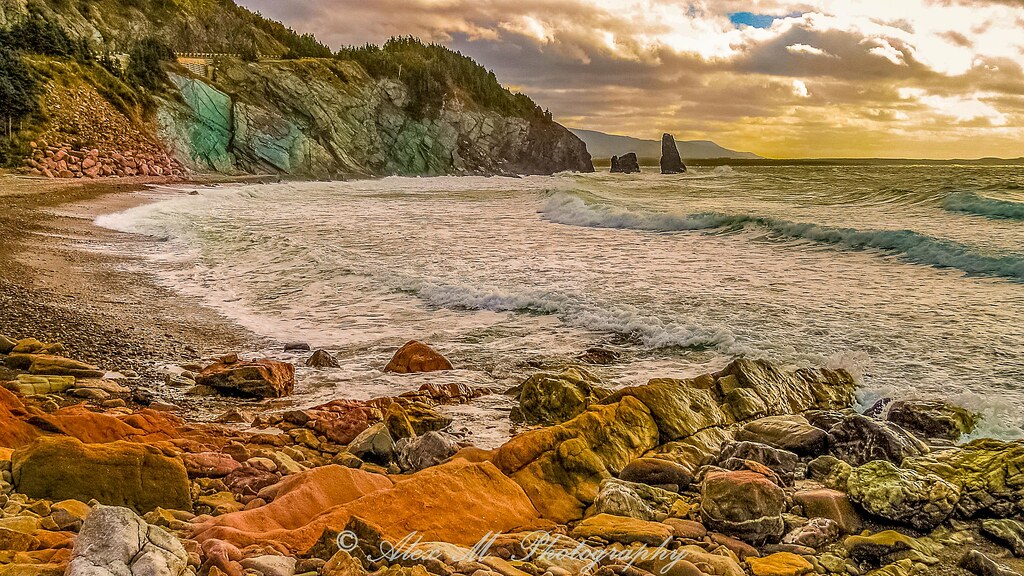Cape Breton Highlands National Park, established in 1936, is a breathtaking wilderness paradise located on the northern tip of Cape Breton Island, Nova Scotia, Canada. This majestic park covers an area of 948 km2 / 366.02 mi2 and offers a diverse landscape of rugged cliffs, sheltered coves, rocky beaches, bogs, and dense forests, all under the constant attack of the Atlantic Ocean.
The park’s natural beauty is truly mesmerizing, and the varied vegetation is sure to impress. The hardwood forests of maple, beech, and yellow birch contrast with the muskeg, heath barrens, and orchid-dotted bogs. The park is home to an array of wildlife species, including moose, white-tailed deer, black bear, snowshoe hare, bobcat, lynx, and possibly cougar. The park is also home to a number of rare and endangered species, such as the rock vole, Gaspé and pygmy shrews, and marten. Over 230 species of birds have been recorded in the park, making it a birdwatcher’s paradise.
The park also has a rich human history, claiming the area as the site of John Cabot’s landfall in 1497. The Micmac people lived in the area then, followed by Portuguese fishermen and French and Scottish immigrants. The tradition is still strong in the fishing villages near the park. French is the first language of many residents, reflecting their Acadian heritage, and the use of Gaelic reflects a Highland heritage.

The park offers a variety of recreational activities and facilities for visitors to enjoy. The 298 km / 185.16 mi Cabot Trail, a modern scenic highway, is one way to experience the park’s beauty. Hiking, camping, and picnicking are popular activities, and there are six vehicle-accessible, fully serviced campgrounds and backcountry sites for those seeking a more wilderness experience. The park also offers guided tours and interpretive programs, allowing visitors to learn more about the park’s natural and cultural history. Fishing, canoeing, and kayaking are also popular activities, with several lakes and rivers in the park providing opportunities for anglers.
For those who want a more exhilarating experience, the park offers rock climbing and rappelling opportunities on the park’s cliffs. The park also offers several scenic drives, including the famous Cabot Trail, which offers breathtaking views of the park’s rugged coastline and the surrounding mountains.

In short, Cape Breton Highlands National Park offers a unique and unforgettable wilderness experience that will delight visitors of all ages and interests. With its breathtaking natural beauty, rich cultural heritage, and wide range of recreational activities, it’s a must-see destination for anyone visiting Nova Scotia.
Did you know about the Cape Breton Highlands National Park?
- Cape Breton Highlands National Park is located on the northern tip of Cape Breton Island, Nova Scotia, Canada, covering an area of 948 km2 / 366.02 mi2.
- The park offers a diverse landscape of rugged cliffs, sheltered coves, rocky beaches, bogs, and dense forests.
- The park is home to an array of wildlife species including moose, white-tailed deer, black bear, snowshoe hare, bobcat, lynx, and possibly cougar.
- The park is also home to a number of rare and endangered species such as the rock vole, Gaspé and pygmy shrews, and marten.
- The park has a rich human history, the area being claimed as the site of John Cabot’s landfall in 1497, and was inhabited by the Micmac people.
- The 298 km / 185.16 mi Cabot Trail, a modern scenic highway is one of the ways to experience the park’s beauty.
- The park offers hiking, camping, picnicking, guided tours, interpretive programs, fishing, canoeing, kayaking, rock climbing, and rappelling
- The park also offers a number of scenic drives, including the famous Cabot Trail, which offers breathtaking views of the park’s rugged coastline and the surrounding mountains.
- The park has over 230 species of birds, making it a birdwatcher’s paradise.
Google Maps of the Cape Breton Highlands National Park
This embeddable Google Map generated for free on Canada Maps.com